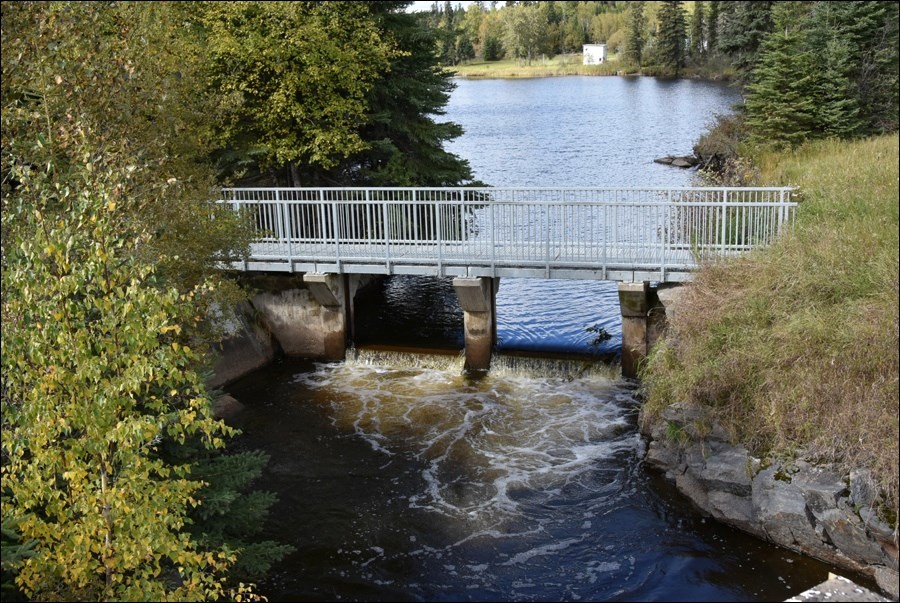A continual variation in the level of Snow Lake has long been a topic of conversation at the coffee shops and kitchen tables within the community. It is a given, while discussing any topic there is healthy disagreement; however, most opining on this subject agree that constant deviations in the lake level are eroding the shoreline and doing irreparable damage.
The Town of Snow Lake heard from one such person at its Sept. 6 regular meeting, when local resident Bob Campbell appeared before council as a delegation.
In addressing council, Campbell noted that he was very concerned with the unusually large fluctuations in the level of the lake over the previous year, saying they were causing shoreline erosion and loss of nesting habitat. He brought a list of questions along with him and as he began his presentation it was obvious some had already been answered in advance.
Snow Lake has a control structure approximately 4 km outside of the community. It is situated at Snow Creek, just next to the bridge that fords it on
PR #392.
The structure was installed in 1972 for the purpose of keeping the lake at a constant level for recreational purposes. At the time the optimum level was 901 ft. above sea level, which is actually the level it currently sits at. But between 1972 and now, there has been a lot of water go under that bridge, and the levels of late have fluctuated wildly.
When the structure was initially installed, it appears that it was monitored and adjusted by the Ministry of Natural Resources. The Town of Snow Lake eventually took on the duty and approximately five years ago it was taken over by the Water Management and Structures Division of the Ministry of Infrastructure and Transportation (MIT).
The design of the control structure is rather archaic. It consists of a bridge over a gate made up of seven 8’ x 7.5” x 7.5” timbers. The level is adjusted by extracting or adding to these timbers from the bridge above.
Campbell’s first question was in respect to the reason for placing the dam on the creek. He said that he’d been told it was put there in the early ’70s for recreational purposes. But he wanted to know who was responsible for raising and lowering the level; and why it wasn’t being responded to in a timely fashion.
Campbell was told that MIT was the agency responsible; however, they reacted to phone calls apprising them of levels and didn’t have anyone locally doing the monitoring.
The delegate also wanted to know why the Town of Snow Lake was no longer looking after the structure, noting that town staff could react to levels immediately and be proactive rather than reactive to elements that could change it.
He was told by the town chief administrative officer (CAO) Jordan Willner that it was unsafe work for town employees.
Campbell countered that he had been told by MIT that the ministry had no problem with the town doing the monitoring as long as staff took a two-hour safety course on procedures.
Coun. Peter Roberts, who is a former town foreman, said there were several reasons the town gave up their control over monitoring the structure. He said that the bridge used to access the control structure was rotting and the logs were heavy and had to be physically jostled in and out of the structure.
“The bridge was eventually replaced,” said Roberts. “But when we asked for a gantry crane to lift the logs, they couldn’t afford one.
“When they come in and do it now they have a gantry crane,” the councillor added.
Mayor Kim Stephen informed council that she had spoken to several long-time residents about lake levels and they agree that the level of the lake has risen steadily since the early 1970s. Stephen said that she walked the Lakeview Trail in the last week and observed that the higher water has eroded the trail to the point where there are sections of it that should be shut down.
The mayor also noted that there are portions of Copper Road and Lakeshore Drive that could actually slide into the lake if fill isn’t added to bolster the shoreline.
Pointing out the current lower level of the lake, the mayor said, “Now is the time put in fill and get the shoreline back to where it was.”
She said, and other council members agreed, that there were too many people calling MIT and informing them of high or low water, saying that one or two people should be designated to do this job.
The mayor thanked Campbell for his presentation and council passed a resolution requesting the level be kept as it is currently 901 ft. above sea level. and further, that the CAO and town foreman be the only people designated to phone MIT to pull or place logs in the control structure.
Of note, Campbell voiced concern during the meeting that the existing level was too low. He felt a level somewhere between the high water in the summer and where it sits today would be best.
In conclusion, throughout Campbell’s presentation, resident Bob Alcorn continually spoke and added comments from the gallery without being recognized by the chair; as a result I did not include anything that he added to the conversation.
My Take on Snow Lake is published on Fridays.




